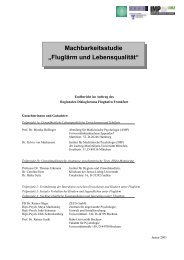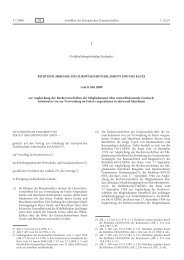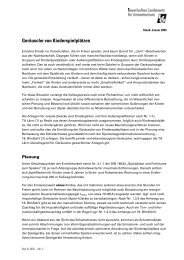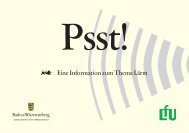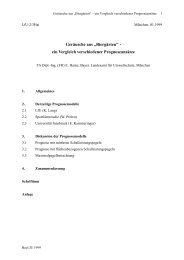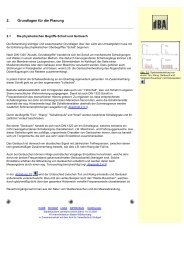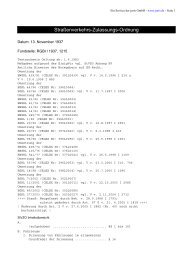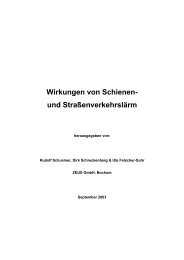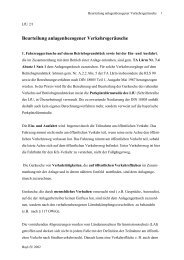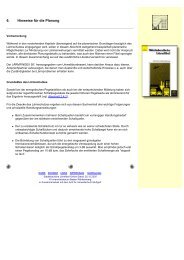Kapitel 5
Kapitel 5
Kapitel 5
You also want an ePaper? Increase the reach of your titles
YUMPU automatically turns print PDFs into web optimized ePapers that Google loves.
5. Noise from leisure and sports facilities<br />
5.2.4 Ordinance on the Prevention of Noise from Sports Facilities (18th<br />
Federal Immission Control Ordinance)<br />
The Ordinance on the Prevention of Noise from Sports Facilities (18th Federal Immission Control<br />
Ordinance from 1991) (available in German) is applicable to the construction, nature and operation of<br />
sports facilities unless they are subject to licensing pursuant to § 4 of the Federal Immission Control<br />
Act. Sports facilities are defined as stationary facilities for exercising operated for this purpose (this<br />
does not include e.g. children's playgrounds or recreational sports activities on paths and in open<br />
land). Sports facilities also cover nearby facilities with a close spatial and operation relation, like<br />
parking lots or restaurants.<br />
The 18th Federal Immission Control Ordinance provides immission guide values for the construction<br />
and operation of sports facilities which shall not be exceeded (table 5/1).<br />
Single short-time peak values may not exceed the immission guide values by more than 30 dB(A)<br />
during the day and more than 20 dB(A) at night.<br />
Furthermore, immission values of 35 dB(A) at daytime and 25 dB(A) at nighttime are designated for<br />
habitable rooms in dwellings which are connected with sports facilities (e.g. within housing<br />
complexes). Single peak values may not exceed the last-mentioned values by more than 10 dB(A).<br />
The determined periods are as follows: Daytime covers the period between 6 am and 10 pm on<br />
weekdays and between 7 am and 10 pm on Sundays and holidays. Nighttime is everything else. Rest<br />
periods are from 6 am to 8 am and from 8 pm to 10 pm on weekdays. On Sundays and holidays, the<br />
rest period is from 7 am to 9 am and from 8 pm to 10 pm plus the two hours from 1 pm to 3 pm. This<br />
noon rest must only be considered if sports facilities are used more than 4 hours on Sundays and<br />
holidays between 9 am and 8 pm.<br />
Uses at daytime at nighttime<br />
outside the rest periods<br />
within the rest<br />
periods<br />
Commercial areas 65 60 50<br />
Core areas, village areas, mixed<br />
areas<br />
60 55 45<br />
General residential areas, small<br />
housing estates<br />
55 50 40<br />
Purely residential areas 50 45 35<br />
Spa areas, rest homes, hospitals 45 45 35<br />
Fig. 5/3: Examples of sports facilities<br />
Table 5/1: Immission guide values in dB(A) pursuant to the 18th Federal Immission Control<br />
Ordinance<br />
Exceptions to the regulations and orders can be made if the noise from sports facilities is superposed<br />
by permanent and predominant extraneous sounds. The competent authority can also fix hours of<br />
operation (except for open-air swimming pools and school sport facilities). Hours of operation shall<br />
not be fixed if the immission values are very rarely exceeded. Exceedances are rare if they occur on<br />
a maximum of 18 calendar days per year.<br />
Immission guide values in the context of rare events may be exceeded by at most 10 dB(A), provided<br />
that a level of 70 dB(A) is by no means exceeded outside the rest period at daytime, that of 65 dB(A)<br />
within the rest period and that of 55 dB(A) at night. Single short-time peak values may not exceed the<br />
immission guide values by more than 20 dB(A) during the day and more than 10 dB(A) at night.<br />
An annex to the ordinance contains the determination and assessment procedure. What must be<br />
considered besides the noise from the sports facility and its equipment is, if necessary, traffic noises<br />
from public circulation areas outside the facility provided that the traffic volume can be assigned to<br />
the facility.<br />
Rating level and maximum level of single peak noises are determined on the basis of intensity, length



